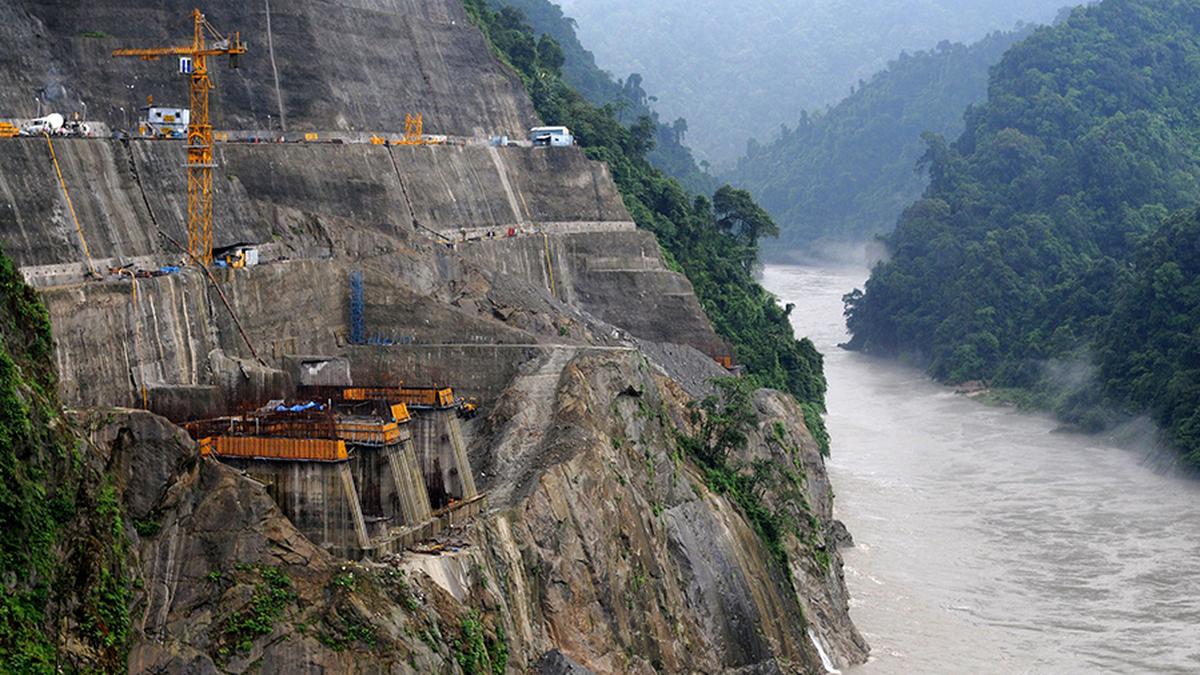Subansiri Dam's Deadline Sparks Downstream Fears in Assam
National NationalPosted by AI on 2025-04-20 07:01:15 | Last Updated by AI on 2025-08-04 00:02:39
Share: Facebook | Twitter | Whatsapp | Linkedin Visits: 6

Will the Subansiri Lower Hydroelectric Project meet its May-end target? The looming deadline for NHPC's ambitious dam on the Assam-Arunachal Pradesh border has ignited serious concerns about downstream impacts, particularly in the flood-prone state of Assam. Environmentalists are raising alarms, emphasizing the absence of a crucial safety net: an independent reservoir management authority.
The Subansiri Lower HE Project, a 2,000 MW behemoth, has been a subject of debate for years. Its potential to generate much-needed power for the region is undeniable. However, the project's location in a seismically active zone and its potential to exacerbate flooding downstream have fueled persistent anxieties among communities in Assam. These fears are further amplified by the impending May-end target for the first unit's commissioning, a deadline that some fear prioritizes speed over safety.
Adding to the unease is the lack of an independent reservoir management authority. In 2019, an expert committee, appointed by the National Green Tribunal, specifically recommended the formation of such an authority. This independent body would be responsible for overseeing the dam's operations, especially crucial during monsoon season, to mitigate downstream risks. Its absence three years later raises critical questions about preparedness and the potential consequences for communities downstream. The concerns revolve around the sudden release of water from the dam, which could lead to devastating floods in the downstream areas, particularly during the monsoon season.
Environmentalists argue that an independent authority, free from the influence of the dam's operator, NHPC, would ensure impartial decision-making regarding water releases and reservoir management. This independent oversight is considered vital to balance the project's power generation goals with the safety and well-being of downstream populations. The authority's role would include real-time monitoring of water levels, weather patterns, and seismic activity to make informed decisions about water releases, minimizing flood risks and ensuring the safety of downstream communities.
The absence of this crucial safeguard highlights the disconnect between expert recommendations and on-the-ground implementation. With the May-end deadline rapidly approaching, the urgency to establish this authority cannot be overstated. The project's progress continues amidst these concerns, leaving a cloud of uncertainty hanging over the downstream communities in Assam.
The situation underscores the complex interplay of development, environmental concerns, and public safety. The Subansiri Lower HE Project exemplifies the challenges inherent in balancing the need for power generation with the responsibility to protect vulnerable populations and ecosystems. The potential for disaster underscores the urgent need for proactive measures, including the immediate establishment of an independent reservoir management authority, to mitigate the risks and ensure that development does not come at the cost of human safety and environmental sustainability. The coming months will be crucial in determining whether the project can truly deliver on its promise of progress without jeopardizing the lives and livelihoods of those living downstream.
Search
Categories
- Sports
- Business
- History
- Politics
- International
- Science & Technology
- Social Issues
- Disaster Management
- Current Affairs
- Education
- Startup Business
- Startup News
- Awards
- Community Services
- Fundraising Events
- Volunteer Services
- Health Initiatives
- Innovations and Initiatives
- In News
- dummybanners
- Awards
- Partners
- Products
- Press Releases
- News
- Fast Check
- South
- సినిమా
- Gallery
- Sunday Chronicle
- Hyderabad Chronicle
- లైఫ్ స్టైల్
- National
- క్రైం
- ట్రెండింగ్
- జాబ్స్
- అంతర్జాతీయo
- బిజినెస్
- రాజకీయం
- బిజినెస్
- సంపాదకీయం
- నవ్య
- చిత్ర జ్యోతి
- క్రీడలు
- జాతీయం
- తెలంగాణ
- తాజా వార్తలు
- మన పార్టీ
- మన నాయకత్వం
- మన విజయాలు
- డౌన్లోడ్స్
- మీడియా వనరులు
- కార్యకర్తలు
- North East Skill Center News
- Government Schemes
- Entrepreneurship Support
- Employment Opportunities
- Skill Training Programs
- Departments
- Investments
- Initiatives
- Resources
- Telangana IT Parks
- Events & Jobs
- Press Releases
- News
- Airport News
- Newtons Laws of Motion
- Karbonn in Business
- Investments in Karbonn
- Company quarterly sales
- Markets
- Auto News
- Industry
- Money
- Advertisements
- Stock target
- Company Updates
- Stock Market
- Company Sales
- Staffing and HR
- Constituency Assembly
- General News
- Srikalahasti Temple
- Bojjala Sudhir Reddy
- Technology & Innovation
- Sports
- Business
- Products
- Industries
- Services & Trainings
- Tools & Resources
- Technology Integration
- Drug Seizures & Arrests
- Telangana Narcotics
- Law & Enforcement
- Rehabilitation
- Nationwide Drug Policing
- Nigeria Seizures
- Global Operations
- Drug Awareness
- Drug Enforcement Tech
- NCB Drug Seizures
- Judicial Crackdown
- India's Surveillance Tools
- Cross-Border Links
- Women Safety
- Cyber Crimes
- Drug Abuse
- Traffic & Road Safety
- Community Connect
- Public Safety Alerts
- Citizen Assistance
- Nellore City News
- Politics & Administration
- Events & Festivals
- Agriculture & Rural
- Business & Economy
- Health & Wellness
Recent News
- Oppo's Innovative Cooling Technology Coming to India with K13 Turbo Series
- Pakistan, Afghanistan & UAE To Play T20I Tri-Series In Sharjah Prior To Asia Cup
- India Vs England 5th Test Day 2 Weather Forecast: Will Rain Delay The Match?
- Surprise Choice! Shardul Thakur Appointed New West Zone Captain
- Boxing Federation Of India Elections Set For August 21
- 'Force Majeure Pause': Odisha FC Suspend Players, Staff Contracts Amid ISL 2025/26 Limbo
- Manchester United Make Enquiry For Manchester City Goalkeeper Stefan Ortega
- Prajwal Revanna's Leaked Videos: Rape Case and 2,000 Obscene Clips